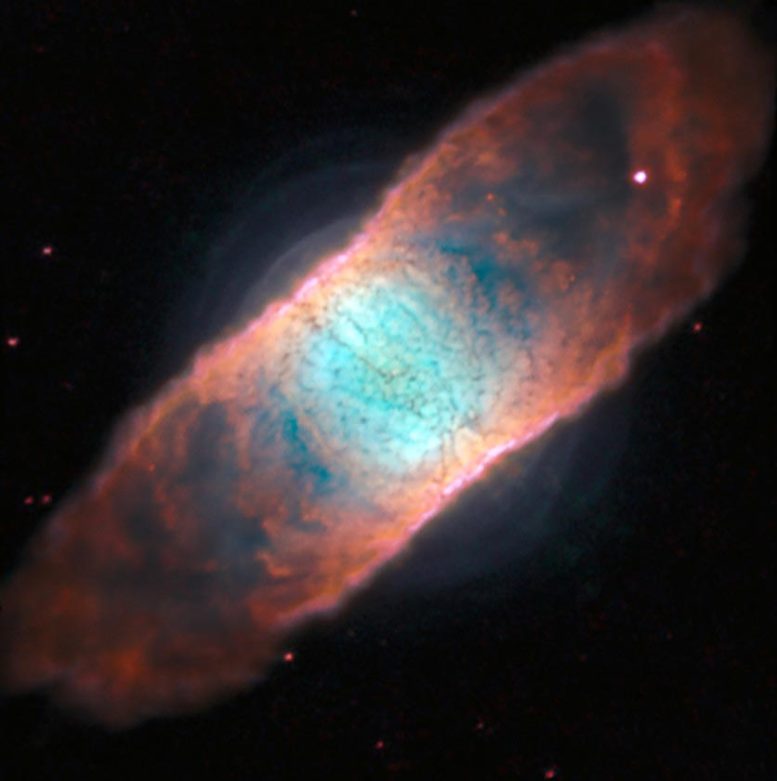
The coupling of the AOF with MUSE gives access to both greater sharpness and a wide dynamic range when observing celestial objects like planetary nebulae. These new observations of IC 4406 revealed shells that have never been seen before, along with the already familiar dark dust structures in the nebula that gave it the popular name the Retina Nebula. This image shows a small fraction of the total data collected by the MUSE using the AOF system and demonstrates the increased abilities of the new AOF-equipped MUSE instrument. Credit: ESO/J. Richard (CRAL)
The Unit Telescope 4 (Yepun) of ESO’s Very Large Telescope (VLT) has now been transformed into a fully adaptive telescope, providing a spectacular improvement in the sharpness of MUSE images.
After more than a decade of planning, construction, and testing, the new Adaptive Optics Facility (AOF) has seen first light with the instrument MUSE, capturing amazingly sharp views of planetary nebulae and galaxies. The coupling of the AOF and MUSE forms one of the most advanced and powerful technological systems ever built for ground-based astronomy.
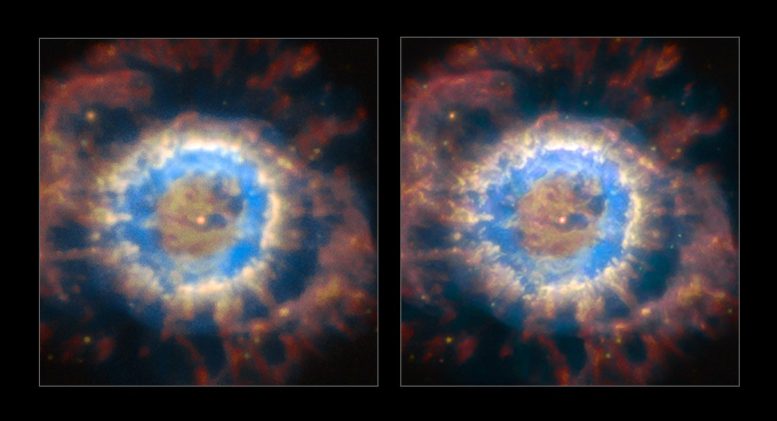
The planetary nebula NGC 6369 seen with natural seeing (left) and when the AOF is providing ground layer correction of the turbulent atmosphere (right). The AOF provides much sharper view of celestial objects and enables access to much finer and fainter structures. Credit: ESO/P. Weilbacher (AIP)
The Adaptive Optics Facility (AOF) is a long-term project on ESO’s Very Large Telescope (VLT) to provide an adaptive optics system for the instruments on Unit Telescope 4 (UT4), the first of which is MUSE (the Multi Unit Spectroscopic Explorer). Adaptive optics works to compensate for the blurring effect of the Earth’s atmosphere, enabling MUSE to obtain much sharper images and resulting in twice the contrast previously achievable. MUSE can now study even fainter objects in the Universe.
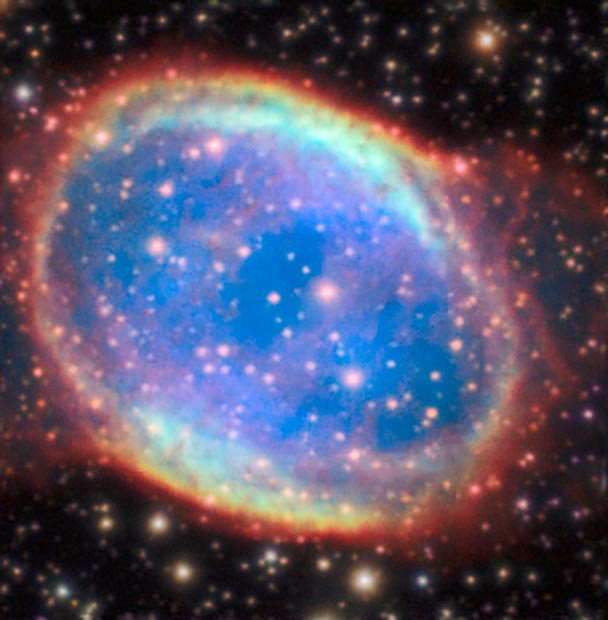
The Adaptive Optics Facility works to remove the blurring effect of Earth’s atmosphere. When used one can see much finer details in the faint planetary nebula NGC 6563 as compared to the natural sky quality. Credit: ESO/P. Weilbacher (AIP)
“Now, even when the weather conditions are not perfect, astronomers can still get superb image quality thanks to the AOF,” explains Harald Kuntschner, AOF Project Scientist at ESO.
Following a battery of tests on the new system, the team of astronomers and engineers were rewarded with a series of spectacular images. Astronomers were able to observe the planetary nebulae IC 4406, located in the constellation Lupus (The Wolf), and NGC 6369, located in the constellation Ophiuchus (The Serpent Bearer). The MUSE observations using the AOF showed dramatic improvements in the sharpness of the images, revealing never before seen shell structures in IC 4406.
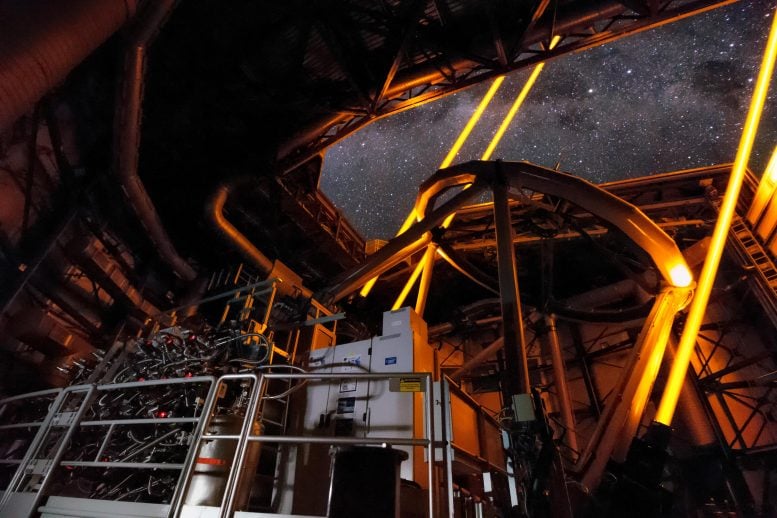
Inside the UT4 of the Very Large Telescope, part of the Adaptive Optics Facility, the four Laser Guide Stars Facility, point to the skies during the first observations using the MUSE instrument. The sharpness and dynamic range of images using the AOF equipped MUSE instrument will dramatically improve future observations. Credit: Roland Bacon/ESO
The AOF, which made these observations possible, is composed of many parts working together. They include the Four Laser Guide Star Facility (4LGSF) and the very thin deformable secondary mirror of UT4. The 4LGSF shines four 22-watt laser beams into the sky to make sodium atoms in the upper atmosphere glow, producing spots of light on the sky that mimic stars. Sensors in the adaptive optics module GALACSI (Ground Atmospheric Layer Adaptive Corrector for Spectroscopic Imaging) use these artificial guide stars to determine the atmospheric conditions.
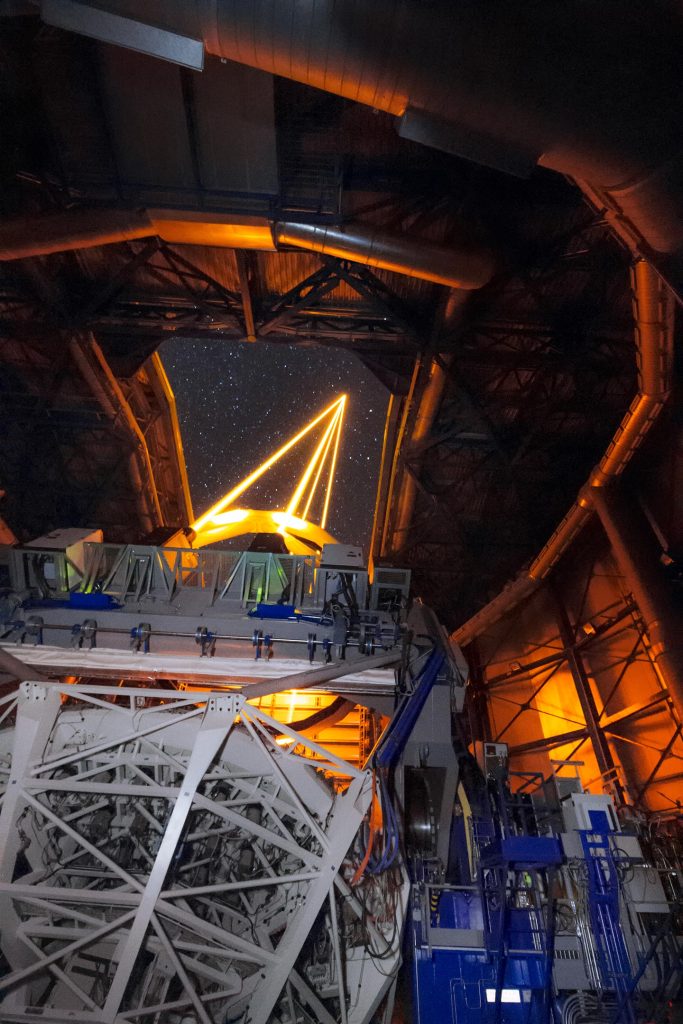
Inside the UT4 of the Very Large Telescope, part of the Adaptive Optics Facility, the four Laser Guide Stars Facility, point to the skies during the first observations using the MUSE instrument. The AOF system is composed of many parts working together to create sharp images of astronomical objects. Credit: Roland Bacon
One thousand times per second, the AOF system calculates the correction that must be applied to change the shape of the telescope’s deformable secondary mirror to compensate for atmospheric disturbances. In particular, GALACSI corrects for the turbulence in the layer of atmosphere up to one kilometer (0.6 miles) above the telescope. Depending on the conditions, atmospheric turbulence can vary with altitude, but studies have shown that the majority of atmospheric disturbance occurs in this “ground layer” of the atmosphere.
ESO’s new Adaptive Optics Facility has just opened its eyes to the sky for the first time. Coupled with the revolutionary instrument MUSE, this is one of the most advanced and powerful technological systems ever built for ground-based astronomy.
“The AOF system is essentially equivalent to raising the VLT about 900 meters higher in the air, above the most turbulent layer of atmosphere,” explains Robin Arsenault, AOF Project Manager. “In the past, if we wanted sharper images, we would have had to find a better site or use a space telescope — but now with the AOF, we can create much better conditions right where we are, for a fraction of the cost!”
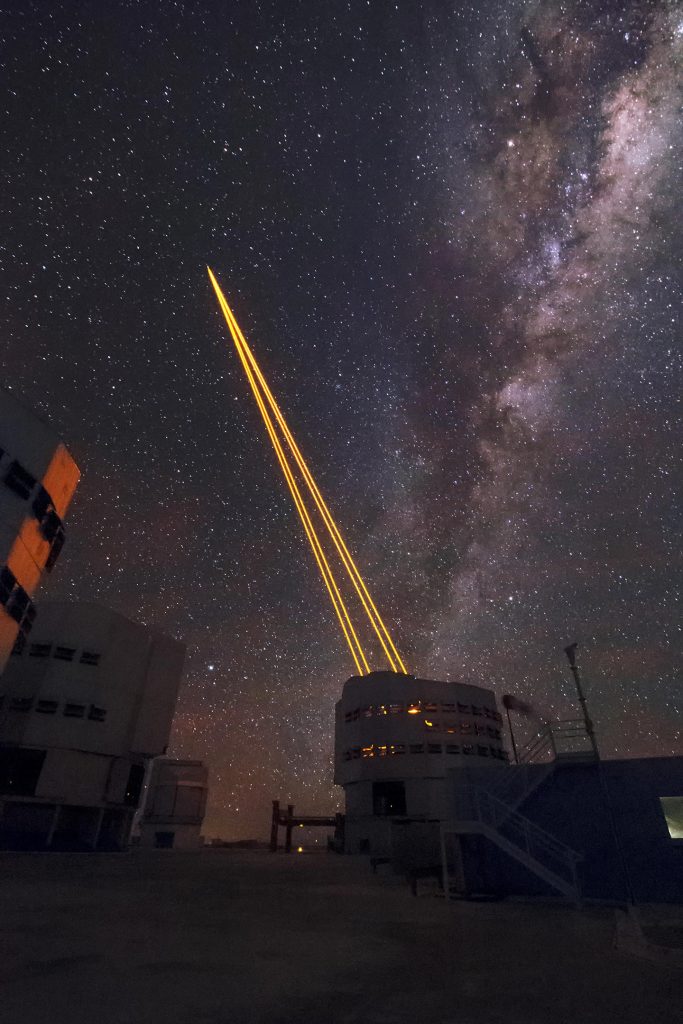
The four Laser Guide Stars Facility points to the skies during the first observations using the AOF-equipped MUSE instrument. Adaptive optics assist ground-based telescopes by compensating for the blurring effect of the Earth’s atmosphere on starlight. Credit: Roland Bacon
The corrections applied by the AOF rapidly and continuously improve the image quality by concentrating the light to form sharper images, allowing MUSE to resolve finer details and detect fainter stars than previously possible. GALACSI currently provides a correction over a wide field of view, but this is only the first step in bringing adaptive optics to MUSE. A second mode of GALACSI is in preparation and is expected to see first light early 2018. This narrow-field mode will correct for turbulence at any altitude, allowing observations of smaller fields of view to be made with even higher resolution.
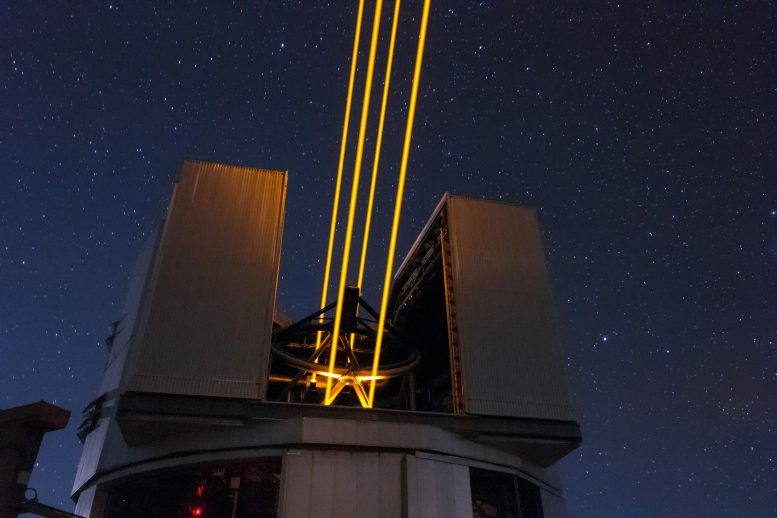
The four 22-watt laser beams make sodium atoms in the atmosphere glow, creating spots of light on the sky that mimic stars. Credit: Roland Bacon
“Sixteen years ago, when we proposed building the revolutionary MUSE instrument, our vision was to couple it with another very advanced system, the AOF,” says Roland Bacon, project lead for MUSE. “The discovery potential of MUSE, already large, is now enhanced still further. Our dream is becoming true.”
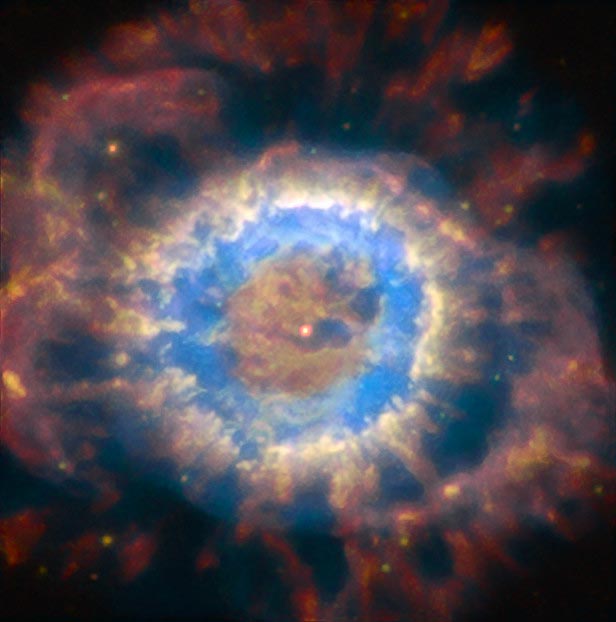
Known as the Little Ghost Nebula, NGC 6369 is a planetary nebula in the constellation Ophiuchus, the serpent-bearer. The nebula is relatively faint with an apparent magnitude of 12.9 and the clear detail of this image shows the power of the AOF-equipped MUSE instrument of the VLT. The white dwarf star is clearly visible in the middle of the nebular gas, which is expanding out in rings. Credit: ESO/P. Weilbacher (AIP)
One of the main science goals of the system is to observe faint objects in the distant Universe with the best possible image quality, which will require exposures of many hours. Joël Vernet, ESO MUSE and GALACSI Project Scientist, comments: “In particular, we are interested in observing the smallest, faintest galaxies at the largest distances. These are galaxies in the making — still in their infancy — and are key to understanding how galaxies form.”
This video of the planetary nebula NGC 6369 shows the exceptional power of the Adaptive Optics Facility (AOF) system coupled with the MUSE instrument of ESO’s Very Large Telescope. The AOF allows MUSE to capture a much sharper view of celestial objects and enables a view of much finer and fainter structures, like the gas in this nebula.
Furthermore, MUSE is not the only instrument that will benefit from the AOF. In the near future, another adaptive optics system called GRAAL will come online with the existing infrared instrument HAWK-I, sharpening its view of the Universe. That will be followed later by the powerful new instrument ERIS.
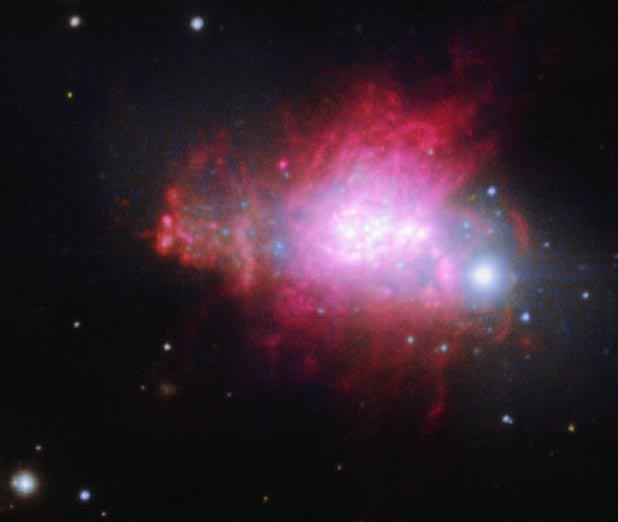
ESO 338-4 is a starburst galaxy located in Sagittarius, the Archer. It is currently in the process of merging, with several smaller galaxies colliding to form the final galaxy. The new AOF+MUSE data clearly resolve several bright knots where intense star formation, induced by the merging, is occurring, as well as filaments of glowing hydrogen gas. Credit: ESO/P. Weilbacher (AIP)
“ESO is driving the development of these adaptive optics systems, and the AOF is also a pathfinder for ESO’s Extremely Large Telescope,” adds Arsenault. “Working on the AOF has equipped us — scientists, engineers, and industry alike — with invaluable experience and expertise that we will now use to overcome the challenges of building the ELT.”
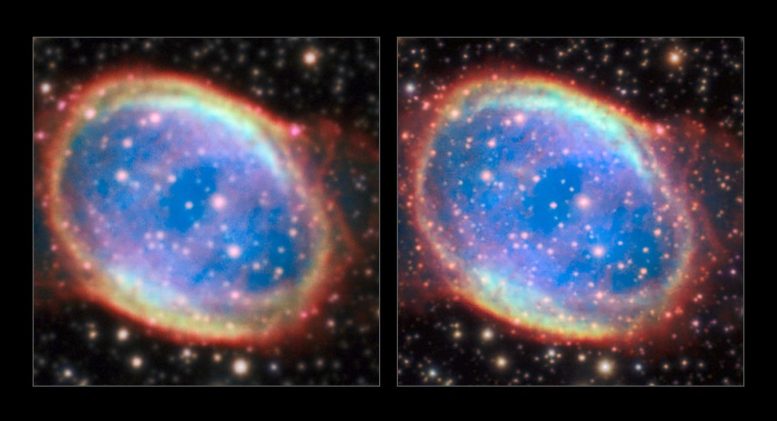
NGC 6563 is a planetary nebula located in the constellation Sagittarius, the Archer. This stunning image obtained with the powerful symbiosis between the AOF and MUSE reveals the faint nebula structures as never seen before. The image on the left is without adaptive optics and the one on the right is with the AOF. Credit: ESO/P. Weilbacher (AIP)

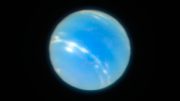
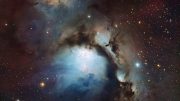
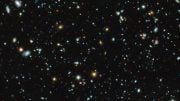
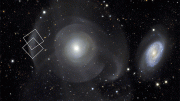
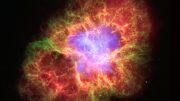
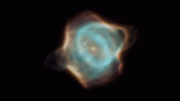
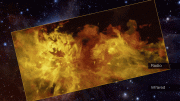
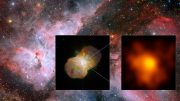
Be the first to comment on "AOF and MUSE Provide Sharp Views of Planetary Nebulae and Galaxies"